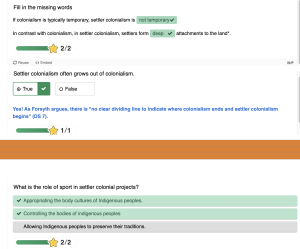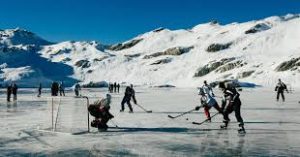6 Chapter 4
Exercise 1: Notebook Prompt
A part of these chapter which stood out to me was talking about settler colonialism and understanding it better. It was something I was unfamiliar with but from in the lecture I was able to get a better grasp and understand truely the evil of it and the displacing and eliminating of indigenous people that took place when settlers settled on a place and essentially removed them.
Exercise 2: Notebook Prompt
Indian Act- Passed in 1876, was a government law which governed many aspects of indigenous people lives. Determined who was recognized as a “status indian” and eligible for benefits and rights. It regulates indigenous life such as with land, certain cultural practices and overrides their traditional leadership structure. It forced assimilation through residential schools and was a tool of colonial control.
Exercise 3:

Exercise 4: Notebook Prompt
This looks like settlers adapting indigenous culture and traditions without proper acknowledgement or understanding of the origin and struggle of the indigenous people. Things such as clothing they wear, sports such as lacrosse are examples of settlers trying to symbolically claim a connection to the land and the history of it with legitimizing their presence. Their attempt strips the actually meaning of these practices and sports of their cultural significance and instead is used as a tool for settlers to try and belong.
Exercise 6: Notebook Prompt
When the residential school staff took pictures they had the aim of trying to portray the schools as efficient, structured instituations when in reality that was very different. Photos often showed students and staff working together to suggest harmony and productivity. Carefully staged photos presented the school in a positive light to the public while it masked the actually realities indigenous children faced and the atrocities occurring there. Group photos often showed students who were dressed very nicely in uniform, some smiling, many others not, and displaying formality reinforcing the illusion of discipline and success happening at these schools.
Exercise 7: Notebook Prompt
In the video the people describe sport as medicine as it gives you the ability to connect to previous generations and ancestors. Sports like lacrosse are sacred as they its called the “medicine game” as its viewed as gifts from the creator which promotes health and well-being. Engaging in sport also helps to preserve culture as playing in these traditional sports helps to preserve indigenous culture. Sport is also a way communities are able to come together as it fosters bonds amongst members and provide a platform for learning and support. Beyond giving fitness, sport is a way of helping both mental and emotional well-being as it can be a outlet for stress and trauma.
Exercise 7: Notebook Prompt
When Waneek Horn-Miller stated that “the government was trying but still approaching indigenous sport development in a very colonial way”, she meant that while there is effort shown by them, the approach is still from a place of colonial framework. These initiatives often impose western structures which often fail to properly respect or integrate indigenous practices and traditions. Instead of empowering themthrough their own beliefs and values, the current approach tends to put indigenous sport into the already colonial system in place. These helps to continue systemic barriers in and overlook the importance of culturally safe spaces which help to honour indigenous sport and identity not place it in with others.
Week 8: Padlet Prompt

Mini Assignment
Call to Action 87
Call 87 is We call upon all levels of government, in collaboration with Aboriginal peoples, sports halls of fame, and other relevant organizations, to provide public education that tells the national story of Aboriginal athletes in history. The steps taken from the Government of Canada alongside organizations such as the Aboriginal Sport Circle have initiated many programs to help honour indigenous athletes and educate people better about them. The Tom Longboat award was relaunched in 2017 to recognize outstanding indigenous athletes. The Canada Sports Hall of Fame has incorporated exhibits which display and help to better educate people about indigenous athletes and the contributions they have made to sports. It aims to educate the public and help to celebrate these figures better. In relation to the communities and individuals can contribute to these call to action, they have a crucial role in helping to advance reconciliation efforts. First is about education in which people must seek in order to be better informed about something. Settlers can educate themselves about indigenous athletes and understand their difficulties they faced and how they overcame them. Utilizing resources readily available such as researching the Tom Longboat award and seeing past receipments as well as Tom Longboat himself. Going to exhibits that are on display can also help to become better informed. Another way is to give their support to indigenous initiatives and participating or even just supporting by giving money or just attending. Programs that celebrate indigenous sports can help to show their significance and foster inclusivity. People can also act as advocates for representation and encouraging local and national sport leagues to better include indigenous sport history and the athletes in their leagues will put more eyeballs on it and promote a more comprehensive understanding of the role indigenous peoples had on Canada’s sports heritage.

